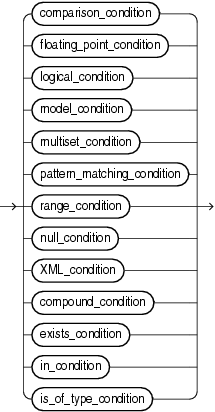| Oracle® Database SQL Language Reference 11g Release 2 (11.2) Part Number E17118-04 |
|
|
PDF · Mobi · ePub |
| Oracle® Database SQL Language Reference 11g Release 2 (11.2) Part Number E17118-04 |
|
|
PDF · Mobi · ePub |
Conditions can have several forms, as shown in the following syntax.

If you have installed Oracle Text, then you can create conditions with the built-in operators that are part of that product, including CONTAINS, CATSEARCH, and MATCHES. For more information on these Oracle Text elements, refer to Oracle Text Reference.
If you are using Oracle Expression Filter, then you can create conditions with the built-in EVALUATE operator that is part of that product. For more information, refer to Oracle Database Rules Manager and Expression Filter Developer's Guide.
The sections that follow describe the various forms of conditions. You must use appropriate condition syntax whenever condition appears in SQL statements.
You can use a condition in the WHERE clause of these statements:
DELETE
SELECT
UPDATE
You can use a condition in any of these clauses of the SELECT statement:
WHERE
START WITH
CONNECT BY
HAVING
Note:
The combined values of theNLS_COMP and NLS_SORT settings determine the rules by which characters are sorted and compared. If NLS_COMP is set to LINGUISTIC for your database, then all entities in this chapter will be interpreted according to the rules specified by the NLS_SORT parameter. If NLS_COMP is not set to LINGUISTIC, then the functions are interpreted without regard to the NLS_SORT setting. NLS_SORT can be explicitly set. If it is not set explicitly, it is derived from NLS_LANGUAGE. Please refer to Oracle Database Globalization Support Guide for more information on these settings.A condition could be said to be of a logical data type, although Oracle Database does not formally support such a data type.
The following simple condition always evaluates to TRUE:
1 = 1
The following more complex condition adds the salary value to the commission_pct value (substituting the value 0 for null) and determines whether the sum is greater than the number constant 25000:
NVL(salary, 0) + NVL(salary + (salary*commission_pct, 0) > 25000)
Logical conditions can combine multiple conditions into a single condition. For example, you can use the AND condition to combine two conditions:
(1 = 1) AND (5 < 7)
Here are some valid conditions:
name = 'SMITH'
employees.department_id = departments.department_id
hire_date > '01-JAN-08'
job_id IN ('SA_MAN', 'SA_REP')
salary BETWEEN 5000 AND 10000
commission_pct IS NULL AND salary = 2100
See Also:
The description of each statement in Chapter 10 through Chapter 19 for the restrictions on the conditions in that statementPrecedence is the order in which Oracle Database evaluates different conditions in the same expression. When evaluating an expression containing multiple conditions, Oracle evaluates conditions with higher precedence before evaluating those with lower precedence. Oracle evaluates conditions with equal precedence from left to right within an expression, with the following exceptions:
Left to right evaluation is not guaranteed for multiple conditions connected using AND
Left to right evaluation is not guaranteed for multiple conditions connected using OR
Table 7-1 lists the levels of precedence among SQL condition from high to low. Conditions listed on the same line have the same precedence. As the table indicates, Oracle evaluates operators before conditions.